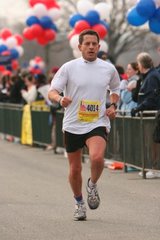Good advice from today's NY Times:
October 12, 2007
Op-Ed Contributor
Running Into Trouble
By FRANK SHORTER
Boulder, Colo.
AT the 16-mile mark of a very hot and humid marathon at the Pan American Games in Cali, Colombia, in 1971, I looked over at my good friend and teammate Kenny Moore and noticed something.
“You’ve stopped sweating,” I said, trying to sound calm.
Kenny looked at his dry forearms, and then his eyes got very big. Ten minutes later he was in an ambulance, incoherent with heat stroke.
We had both expected extreme conditions and had prepared accordingly all summer. But it was not his day, and I went on the win the race. (The next summer, Kenny would finish fourth in the Olympic Marathon in Munich, which I won.) In Cali, my genetics had prevailed: some athletes simply handle heat and humidity better than others.
For many runners — especially non-elite runners who, after all, are on the course much longer — last Sunday’s Chicago Marathon was Kenny Moore’s Cali experience writ large: temperatures in the 80s, dozens hospitalized, one death and the race halted. I was in Chicago, and after watching the elite runners finish, I took off on a 1 hour, 50 minute training run to see for myself what it was like.
I think several factors combined to turn the race into a worst-case scenario.
Lake Michigan was like glass, and I realized early in my run that I wasn’t being cooled by any wind. Even though the temperature/humidity index was in the danger zone, it was the stillness that slammed the door on the runners, and ultimately on the race itself.
One theory I have is that when your body has to work so hard to get blood to your skin to cool off, the margin of error when you run above your level of ability shrinks substantially. Not being acclimated compounds the problem. Your perception of how much to slow down to avoid an emergency gets distorted. Blood flow that would normally be helping muscles recover from a pacing mistake is instead shunted to the skin for cooling.
The organizers in Chicago were prepared for a hot race, though not one this hot — no one had expected the record temperatures, not even the top runners, who hadn’t made getting used to heat and humidity a part of their training. (It takes about two weeks to acclimate to hot, humid conditions.) If the runners at the back of the pack in Chicago — whose flat course tends to attract first-timers — were physiologically caught off guard, so were some of the elite runners.
The weather was unique and dangerous, and as soon as that became apparent the organizers decided to get everyone to safety as soon as possible. To me it was obvious that concern for the runners came first and all other interests second.
How can marathon participants — runners and organizers both — prepare for such conditions? Some thoughts:
•
Make salt packets available at the start of races that are dangerously hot. In this context, salt is a good thing.
•
Strip down. At the expo before the Chicago race, I advised men to go shirtless and women to wear as little as possible in order to maximize the refrigeration effect of wind against sweaty skin. (Unfortunately, this time there would be no wind.) The elite runners have learned this. In Chicago, I would have gone shirtless, and explained to my sponsors later.
•
Have showers and misters at every aid station. In Chicago, drinking water ran out after runners poured hundreds of thousands of cups over their heads.
•
Talk. Run at what I call a “conversational pace.” As long as you can carry on a normal conversation and don’t have to pause to get a breath, you’re getting enough oxygen. This is your only real protection against going over the edge to the point where your body has to recover, because in extreme conditions, you might discover that it can’t.
•
Make clear to first-time marathoners what elite runners already know: in certain situations it’s important to back off from the gut feeling to exert yourself more and more just to maintain the pace.
•
Change the standard ambulance procedures so that only those truly in danger are transported. Doctors will tell you that dehydration can often be initially handled on the scene, but many ambulance protocols call for sufferers to be transported automatically to the hospital.
•
Make dropping out palatable. Runners, especially first-timers and those running for charity, should be given the option of getting their money back and perhaps a guaranteed entry at a major marathon in the near future. Race directors could easily cooperate on this. Peer-group and self-imposed pressure to follow through on months of training should be alleviated as much as possible. Fund-raising groups should underwrite a second try for those giving so much of themselves for the benefit of others.
•
If necessary, turn off the clock.
I hope the Chicago experience results in a more flexible attitude on the part of all race organizers in terms of giving runners the option of saving it for another day, and that inexperienced runners are motivated to learn all they can about what they’re getting themselves into.
As for the elite runners — for whom it’s less of a health issue — my advice would still be to think of my friend Kenny Moore in Cali. Because no matter who you are, it just might not be your day.
Frank Shorter, the 1972 Olympic gold medalist and 1976 Olympic silver medalist in the marathon, was the first chairman of the United States Anti-Doping Agency.
Friday, October 12, 2007
Subscribe to:
Post Comments (Atom)












No comments:
Post a Comment